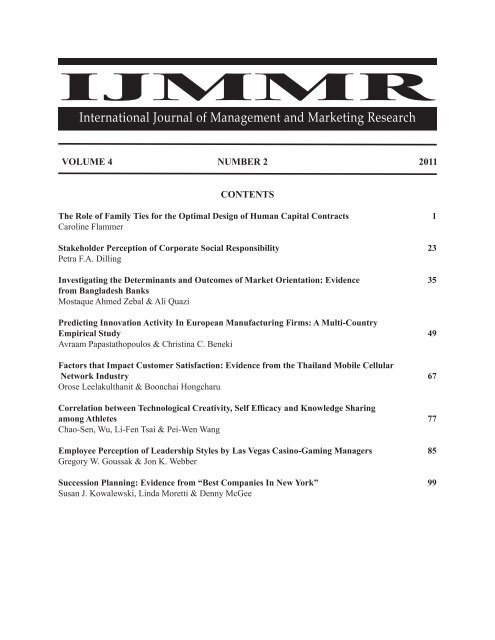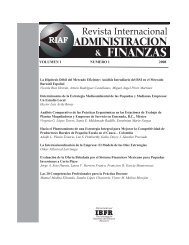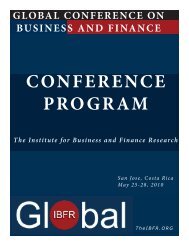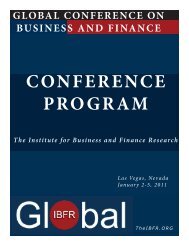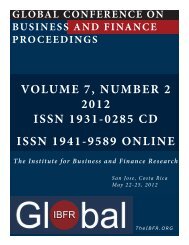ijmmr - The Institute for Business and Finance Research (IBFR)
ijmmr - The Institute for Business and Finance Research (IBFR)
ijmmr - The Institute for Business and Finance Research (IBFR)
Create successful ePaper yourself
Turn your PDF publications into a flip-book with our unique Google optimized e-Paper software.
IJMMR<br />
International Journal of Management <strong>and</strong> Marketing <strong>Research</strong><br />
VOLUME 4 NUMBER 2<br />
2011<br />
CONTENTS<br />
<strong>The</strong> Role of Family Ties <strong>for</strong> the Optimal Design of Human Capital Contracts 1<br />
Caroline Flammer<br />
Stakeholder Perception of Corporate Social Responsibility 23<br />
Petra F.A. Dilling<br />
Investigating the Determinants <strong>and</strong> Outcomes of Market Orientation: Evidence 35<br />
from Bangladesh Banks<br />
Mostaque Ahmed Zebal & Ali Quazi<br />
Predicting Innovation Activity In European Manufacturing Firms: A Multi-Country<br />
Empirical Study 49<br />
Avraam Papastathopoulos & Christina C. Beneki<br />
Factors that Impact Customer Satisfaction: Evidence from the Thail<strong>and</strong> Mobile Cellular<br />
Network Industry 67<br />
Orose Leelakulthanit & Boonchai Hongcharu<br />
Correlation between Technological Creativity, Self Efficacy <strong>and</strong> Knowledge Sharing<br />
among Athletes 77<br />
Chao-Sen, Wu, Li-Fen Tsai & Pei-Wen Wang<br />
Employee Perception of Leadership Styles by Las Vegas Casino-Gaming Managers 85<br />
Gregory W. Goussak & Jon K. Webber<br />
Succession Planning: Evidence from “Best Companies In New York” 99<br />
Susan J. Kowalewski, Linda Moretti & Denny McGee
INTERNATIONAL JOURNAL OF MANAGEMENT AND MARKETING RESEARCH ♦Volume 4 ♦ Number 2 ♦ 2011<br />
THE ROLE OF FAMILY TIES FOR THE OPTIMAL<br />
DESIGN OF HUMAN CAPITAL CONTRACTS<br />
Caroline Flammer, Kean University<br />
ABSTRACT<br />
This paper studies the problem of financing a child's primary education when the parent is faced with<br />
credit constraints, contracting with minors is not possible <strong>and</strong> the legal en<strong>for</strong>ceability of contracts is<br />
limited – a profound problem in many developing countries. It presents a model in which the empathy of<br />
agents towards their kinship ("family ties") is endogenized <strong>and</strong> self-en<strong>for</strong>cement of contracts is<br />
guaranteed through the interlinkage of credit markets – first a market <strong>for</strong> education credits, then a market<br />
<strong>for</strong> personal credits such as microcredits. We analyze the impact of increased mobility <strong>and</strong> anonymity<br />
observed in developing societies on the optimal contract design <strong>and</strong> allow <strong>for</strong> imperfect in<strong>for</strong>mation. <strong>The</strong><br />
main results are as follows: a decrease in in<strong>for</strong>mation flow (regarding traceability of the whereabouts as<br />
well as borrowers' credit history) causes the interest rate of the education credit to always decrease,<br />
while the effect on the interest rate of the microcredit is ambiguous. <strong>The</strong> latter falls if the parent's<br />
empathy towards its child is independent of the child's empathy. Furthermore, we find that family ties not<br />
only represent an insurance <strong>for</strong> the family members against financial distress but can also dampen the<br />
negative effect of limited en<strong>for</strong>cement on the lender's payoff.<br />
JEL: D64; D86; I22; O12; O16<br />
KEYWORDS: En<strong>for</strong>cement, Microfinance, Credit Markets, Education, Human Capital, Empathy.<br />
INTRODUCTION<br />
A<br />
profound problem of many developing countries is that access to primary education as well as<br />
(legal) en<strong>for</strong>ceability of contracts are limited. This paper addresses both issues <strong>and</strong> designs a<br />
contract that is self-en<strong>for</strong>cing <strong>and</strong> promises to improve access to primary education without<br />
relying on traditional collateral or contracting with minors.<br />
Even today, children from poor families often have limited or no access to primary education, not so<br />
much because of direct costs like school fees but mostly because of insurmountable indirect costs. <strong>The</strong>se<br />
costs include, <strong>for</strong> example, tuition fees, school materials, uni<strong>for</strong>ms, transportation <strong>and</strong> lost earnings.<br />
Instead of attending school on a daily basis, children typically work in order to make a living. <strong>The</strong> lack of<br />
means makes borrowing vital in order to pursue an education. However, poor families hardly qualify <strong>for</strong><br />
credits from conventional banks due to a lack of (traditional) collateral <strong>and</strong> eligible guarantors.<br />
<strong>The</strong> only remedy is often seen in microfinance, which neither relies on traditional collateral nor legal<br />
en<strong>for</strong>ceability of contracts but on alternative mechanisms in order to guarantee the self-en<strong>for</strong>cement of<br />
contracts. For example, social pressure as well as the threat of confiscating personal belongings is used in<br />
order to enhance compliance. <strong>The</strong> belongings might be of only little market value but their subjective<br />
value, which is most decisive, can be excessively high. A further highly effective instrument is dynamic<br />
lending, i.e. the promise of a continuing business connection <strong>for</strong> complying borrowers, where credit is<br />
increased over time (<strong>for</strong> an overview of instruments, see, e.g., Armendàriz de Aghion <strong>and</strong> Morduch, 2004,<br />
2005; Ledgerwood, 1999; Morduch, 1999).<br />
Microfinance institutions (MFIs) provide a wide range of services to individuals – or groups of<br />
individuals – in order to support <strong>and</strong> consequently help them out of poverty. <strong>The</strong> best-known service is<br />
1
INTERNATIONAL JOURNAL OF MANAGEMENT AND MARKETING RESEARCH ♦Volume 4 ♦ Number 2 ♦ 2011<br />
STAKEHOLDER PERCEPTION OF CORPORATE<br />
SOCIAL RESPONSIBILITY<br />
Petra F.A. Dilling, New York <strong>Institute</strong> of Technology<br />
ABSTRACT<br />
As corporate social responsibility receives increased attention by company stakeholders, researchers are<br />
also increasingly exploring corporate social responsibility, its causes <strong>and</strong> implications. However little is<br />
known about the perception of corporate social responsibility. This study explores the link between<br />
stakeholder perception of corporate social responsibility <strong>and</strong> its relationship with underlying factors. <strong>The</strong><br />
findings suggest that age of the corporation, community involvement, <strong>and</strong> cultural diversity have a<br />
significant influence on corporate social responsibility perception by stakeholders. Another importance is<br />
issue is the existence of a published corporate social responsibility or sustainability report. No significant<br />
results were found <strong>for</strong> the sustainable use of natural resources <strong>and</strong> Dow Jones Sustainability Index<br />
inclusion. <strong>The</strong> study concludes with recommendations <strong>for</strong> corporations on how they can enhance<br />
perception of corporate social responsibility by stakeholders.<br />
JEL: M14, M39, M49, Q01<br />
KEYWORDS: corporate social responsibility, stakeholder perception, sustainability reporting, cultural<br />
diversity, community investment, sustainable use of natural resources<br />
INTRODUCTION<br />
I<br />
n a definition proposed by the Commission of the European Communities corporate social<br />
responsibility (CSR) is described as societal responsibility <strong>for</strong> a company to integrate social <strong>and</strong><br />
environmental concerns into their activities <strong>and</strong> stakeholder relationships on a voluntary basis<br />
(European Commission, 2002). <strong>The</strong> World <strong>Business</strong> Council <strong>for</strong> Sustainable Development describes CSR<br />
as “commitment of business to contribute to sustainable economic development, working with employees,<br />
the local community <strong>and</strong> society” (World <strong>Business</strong> Council <strong>for</strong> Sustainable Development, 2000). In the<br />
literature, many definitions have been developed, from various angles <strong>and</strong> in multiple contexts. For a<br />
summary of definitions, refer to Swaen & Chumpitaz (2008). However, until now, a common definition<br />
of CSR has not been established (Mutch & Aitken, 2009). Nonetheless, companies are increasingly<br />
devoting significant resources to demonstrate their CSR commitment (Swaen & Chumpitaz, 2008).<br />
When we look <strong>for</strong> reasons behind this commitment we find that some corporations invest in CSR because<br />
it is the "right thing to do"; it is aligned with the beliefs of the management <strong>and</strong> corporate culture; it is<br />
part of the strategic plan; it is a current thing to do as most of the other organizations do it; or<br />
management expects to be rewarded <strong>for</strong> it by the market. Regarding the latter, numerous studies have<br />
been devoted to exploring the linkage between CSR <strong>and</strong> financial per<strong>for</strong>mance. In the existing literature,<br />
there is still no consensus on the question if suitable CSR programs will lead to better corporate financial<br />
per<strong>for</strong>mance. About seventy percent of related studies showed a positive <strong>and</strong> statistically relevant<br />
relationship between CSR <strong>and</strong> financial per<strong>for</strong>mance (Dilling, 2010). Martin Curran provides a systematic<br />
review of evidence on the relationship between CSR <strong>and</strong> financial per<strong>for</strong>mance (Martin Curran, 2005).<br />
Delivering profits to shareholders is important, but organizations are also subject to broader stakeholder<br />
interests as well as the need to demonstrate a balanced perspective towards doing business (Maon et al.,<br />
2009).<br />
23
INTERNATIONAL JOURNAL OF MANAGEMENT AND MARKETING RESEARCH ♦Volume 4 ♦ Number 2 ♦ 2011<br />
INVESTIGATING THE DETERMINANTS AND<br />
OUTCOMES OF MARKET ORIENTATION: EVIDENCE<br />
FROM BANGLADESH BANKS<br />
Mostaque Ahmed Zebal, Abu Dhabi University, UAE<br />
Ali Quazi, University of Canberra, Australia<br />
ABSTRACT<br />
This paper aims at identifying the determinants <strong>and</strong> outcomes of market orientation in the context of a<br />
developing country - Bangladesh. To this end, the validity of the well established Market Orientation<br />
(MARKOR) scale was tested using samples drawn from the private banking sector in Bangladesh. <strong>The</strong><br />
study revealed support <strong>for</strong> the validity of the MARKOR scale when applied to Bangladesh. Stepwise<br />
regression <strong>and</strong> univariate test were per<strong>for</strong>med <strong>for</strong> searching the answer <strong>for</strong> the research questions of this<br />
study. <strong>The</strong> findings of this research have important implications <strong>for</strong> marketing policies of firms operating<br />
in developing countries in general <strong>and</strong> Bangladesh in particular<br />
JEL: M31<br />
KEYWORDS: Market Orientation, MARKOR, Banks, Developing Country, Bangladesh<br />
INTRODUCTION<br />
O<br />
ver the last decade, the issue of market orientation has generated considerable interest <strong>and</strong><br />
synergy in the academic <strong>and</strong> business circles considering the critical role that market orientation<br />
can play in business success (Narver <strong>and</strong> Slater, 1990; Jaworski <strong>and</strong> Kohli, 1993; Slater <strong>and</strong><br />
Narver, 1994a). Webster (1994) noted that, <strong>for</strong> the sake of survival in the increasingly competitive<br />
markets in the future, every business needs to be customer-focused, market driven, global oriented, <strong>and</strong><br />
flexible to be able to deliver superior value to customers. Hence, Pulendran et al. (2000) found a positive<br />
relationship between market orientation <strong>and</strong> business per<strong>for</strong>mance. Customer preferences <strong>and</strong><br />
expectations are changing rapidly with the increasing exposure to new product offerings <strong>and</strong><br />
communicating the new offerings to customers. As a consequence, market orientation has emerged as a<br />
vital element in current market practices as well as in contemporary marketing literature <strong>and</strong> in marketing<br />
thoughts <strong>and</strong> theories (Svensson, 2001).<br />
Further, there has been a trend of speedy change in the modern business world due to the fact of<br />
worldwide rapid change in customers’ needs <strong>and</strong> wants. In addition, adoption of new technology, change<br />
of business legislation, <strong>and</strong> competitive intensity in the market place make the market <strong>for</strong> a particular<br />
product more volatile. <strong>The</strong>se are in fact different challenges that a particular organization likely to face on<br />
a regular basis in its day to day business operations. Now the question is; how a particular organization<br />
may face these challenges. Can that be done by being a market oriented organization? In order to search<br />
answers <strong>for</strong> these questions, this paper investigates if market orientation can work as one of the weapons<br />
to face theses challenges. Further, it has been a common knowledge that market orientation helps<br />
maintain a successful business relationship aimed at gaining superior financial per<strong>for</strong>mance in a rapidly<br />
changing competitive posture in domestic as well as in international markets. Thus considering all these<br />
issues, selecting market orientation <strong>for</strong> this study seems justified.<br />
Market orientation has been investigated with reference to the consumer goods manufacturing sector in<br />
Bangladesh (Zebal, 2005), but there has been no research done in the context of the service sector. Paul<br />
(2006) noted the paucity of research on this issue in the context of South <strong>and</strong> Central Asian countries<br />
35
INTERNATIONAL JOURNAL OF MANAGEMENT AND MARKETING RESEARCH ♦Volume 4 ♦ Number 2 ♦ 2011<br />
PREDICTING INNOVATION ACTIVITY IN EUROPEAN<br />
MANUFACTURING FIRMS: A MULTI-COUNTRY<br />
EMPIRICAL STUDY<br />
Avraam Papastathopoulos, Technological Educational <strong>Institute</strong> of Ionian Isl<strong>and</strong>s<br />
Christina C. Beneki, Technological Educational <strong>Institute</strong> of Ionian Isl<strong>and</strong>s<br />
ABSTRACT<br />
<strong>The</strong> purpose of this paper is to investigate the factors that influence the Internal Process Innovation (IPI)<br />
Activity of the European manufacturing firms. Moreover, a predictive model is developed that can be<br />
used to predict which manufacturing firms are more likely to introduce any new or significantly improve<br />
their internal processes. This survey is part of the “e-<strong>Business</strong> Watch,” a service launched in 2007 <strong>and</strong><br />
provided by “empirica GmbH” to the European Commission, Enterprise <strong>and</strong> Industry Directorate<br />
General, in co-operation with renowned international partners. In the present study, 914 European<br />
manufacturing small, medium <strong>and</strong> large enterprises were examined <strong>and</strong> a set of hypotheses, regarding<br />
their innovation activity, were developed. <strong>The</strong> results showed that the adoption of Enterprise Resource<br />
Planning (ERP), Customer Relationship Management (CRM) <strong>and</strong> the electronic in<strong>for</strong>mation exchange<br />
between business partners are positively related to firm’s process innovation activity. Moreover, the<br />
results revealed that the employment of ICT-qualified employees, investments in ICTs, firm size <strong>and</strong> longterm<br />
relationships with suppliers also played a major role <strong>for</strong> European manufacturing firms to conduct<br />
internal innovations. <strong>The</strong> paper highlights the fact that the innovation activity of the firms is deeply<br />
affected by a number of different factors, both internally <strong>and</strong> externally.<br />
JEL: L6; M1; O32; O33<br />
KEYWORDS: Innovation activity, Processes improvement, ICT, Manufacturing firms<br />
INTRODUCTION<br />
Innovation is crucial <strong>for</strong> ensuring competitiveness of companies <strong>and</strong> industries (Galia <strong>and</strong> Legros, 2004;<br />
Tourigny <strong>and</strong> Le, 2004; Storey, 2000). In our days, firm’s survival is often dependent on the degree to<br />
which they incorporate innovation into their business strategy, especially because of increasing global<br />
competition (Cefis <strong>and</strong> Marsili, 2006). It is widely accepted that firms, which successfully satisfy market<br />
dem<strong>and</strong>s <strong>and</strong> customer preferences can develop <strong>and</strong> maintain a long-term competitive advantage<br />
(Panayides, 2006). <strong>The</strong> ability to introduce innovation often depends on the adoption <strong>and</strong> use of<br />
advanced technologies, such as In<strong>for</strong>mation <strong>and</strong> Communication Technologies (ICT). <strong>The</strong> last twenty<br />
years the value <strong>and</strong> the importance of ICT have become increasingly decisive <strong>and</strong> ubiquitous in all<br />
organizational processes. Technology exerts an important impact on social <strong>and</strong> financial innovation <strong>and</strong><br />
development (of societies <strong>and</strong> economies) since a long time ago. <strong>The</strong> Global In<strong>for</strong>mation Technology<br />
Report 2006–2007 makes its appearance at a critical juncture as far as the impact of ICT on the world<br />
economy is concerned. <strong>The</strong>re is growing evidence that ICT is driving innovation by allowing creative<br />
thinking <strong>and</strong> responsive problem-solving to provide the promise of unprecedented opportunities <strong>for</strong> all<br />
(Dutta <strong>and</strong> Mia, 2007). <strong>The</strong> rapid deployment of the internet, the corporate databases <strong>and</strong> in<strong>for</strong>mationenterprise<br />
systems accelerated this process of modifications to enterprises’ internal <strong>and</strong> external<br />
environment. This new ‘technology-driven’ situation <strong>and</strong> its possible evolution provide abundant new<br />
challenges in all functional areas across the enterprise (Carneiro, 2006).<br />
ICT has far-reaching properties. It is a so-called general purpose technology, or “key enabling<br />
technology”, with three basic characteristics: it is pervasive as it spreads to most sectors of the economy;<br />
49
INTERNATIONAL JOURNAL OF MANAGEMENT AND MARKETING RESEARCH ♦Volume 4 ♦ Number 2 ♦ 2011<br />
FACTORS THAT IMPACT CUSTOMER<br />
SATISFACTION: EVIDENCE FROM THE THAILAND<br />
MOBILE CELLULAR NETWORK INDUSTRY<br />
Orose Leelakulthanit, National <strong>Institute</strong> of Development Administration<br />
Boonchai Hongcharu, National <strong>Institute</strong> of Development Administration<br />
ABSTRACT<br />
Retaining current customers is one of the key success factors to survive in the mature market of the<br />
mobile cellular network industry in Thail<strong>and</strong>. <strong>The</strong> aim of this study is to identify key success factors of<br />
this industry. Adult users of mobile cellular networks are interviewed. <strong>The</strong> results from the multiple<br />
regression analysis show that from the mobile service perspective, the customer values network quality,<br />
emotional value, promotional value, quality of service at shops <strong>and</strong> quality of call center service. From a<br />
more holistic perspective, corporate image plays a significant role in enhancing customer satisfaction<br />
with mobile cellular networks in Thail<strong>and</strong>.<br />
JEL: L96; M31<br />
KEYWORDS: Customer Satisfaction, mobile phone networks, utilitarian value, hedonic value<br />
INTRODUCTION<br />
T<br />
he Thai mobile network industry has nearly reached its saturation point, as indicated by the<br />
penetration rate of around 99% or 63 million mobile subscribers. Although the industry is<br />
characterized by a few big players in the market; namely, Advance Info Service (AIS), Total<br />
Access Communication (DTAC), <strong>and</strong> True Move, with a market share of 43%, 30% <strong>and</strong> 24%,<br />
respectively, competition intensifies during the industry maturity stage. It is often noted that once<br />
customers have been acquired <strong>and</strong> connected to a particular telecommunications network, long-term links<br />
with the focal operator are more importance to the company success in competitive markets than in other<br />
industries. A key motivation <strong>for</strong> the growing emphasis on customer satisfaction (CS) is that higher CS can<br />
lead to a stronger competitive position, resulting in higher market share <strong>and</strong> profit (Fornell, 1992). It can<br />
lower price elasticity, business cost, failure cost, <strong>and</strong> costs <strong>for</strong> attracting new customers. CS is also<br />
generally assumed to be a significant determinant of repeated sales, positive word-of-mouth, <strong>and</strong><br />
customer loyalty. Satisfied customers return <strong>and</strong> buy more, <strong>and</strong> tell other people about their experiences<br />
(Fornell, Johnson, Anderson <strong>and</strong> Bryant, 1996). Firms that practice CS enhancement strategies usually<br />
gain a sustainable competitive advantage. Satisfaction has been widely studied as a predictor of customer<br />
loyalty (e.g., Cronin, Brady <strong>and</strong> Hult 2000; Fornell, Johnson, Anderson <strong>and</strong> Bryant 1996; Kim, Park <strong>and</strong><br />
Jeong, 2004; Olsen, 2002; Yang <strong>and</strong> Peterson, 2004). CS is an important factor <strong>for</strong> the long-term<br />
relationship between a firm <strong>and</strong> a customer (Anderson <strong>and</strong> Srinivasan, 2003). In order to shed light on the<br />
success of the companies in the telecommunications industry, this study investigates factors affecting CS<br />
with mobile cellular networks.<br />
<strong>The</strong> study begins with a literature review on the factors that impact customer satisfaction. Next the data<br />
<strong>and</strong> methodology are discussed. <strong>The</strong> following section discusses the results. Somne concluding<br />
comments close the paper.<br />
67
INTERNATIONAL JOURNAL OF MANAGEMENT AND MARKETING RESEARCH ♦Volume 4 ♦ Number 2 ♦ 2011<br />
CORRELATION BETWEEN TECHNOLOGICAL<br />
CREATIVITY, SELF EFFICACY AND KNOWLEDGE<br />
SHARING AMONG ATHLETES<br />
Chao-Sen, Wu, TransWorld University, Taiwan<br />
Li-Fen Tsai, TransWorld University, Taiwan<br />
Pei-Wen Wang, TransWorld University, Taiwan<br />
ABSTRACT<br />
<strong>The</strong> main purposes of this study were to investigate the influence of technological creativity <strong>for</strong> sports,<br />
self-efficacy <strong>and</strong> knowledge sharing , <strong>and</strong> to analyze the correlation between technological creativity <strong>for</strong><br />
sports <strong>and</strong> knowledge sharing, via the mediating effect of athletes’ self-efficacy. This study selected<br />
current athletes, including tennis players, track <strong>and</strong> field athletes, volleyball players, etc. as the subjects,<br />
with a total of 250 athletes. Statistical methods, such as Cronbach’s α, factor analysis, Pearson’s<br />
correlation, regression analysis, <strong>and</strong> path analysis, were used to per<strong>for</strong>m analyses. It was found that on<br />
the technological creativity <strong>for</strong> sports , athletes’ creativity <strong>and</strong> technological capacity had significant<br />
positive influence <strong>for</strong> self-efficacy. In other words, the improvement in athletes’ self-efficacy may<br />
improve their creativity <strong>and</strong> level of technological capacity. <strong>The</strong>re<strong>for</strong>e, it is necessary <strong>for</strong> coaches to<br />
constantly strengthen athletes’ self-efficacy <strong>and</strong> provide them with the space <strong>for</strong> the development of<br />
creativity <strong>and</strong> technological capacity in order to specifically improve their athletic per<strong>for</strong>mance.<br />
JEL: M12<br />
KEYWORDS: Knowledge Sharing , Self-efficacy, Technological Creativity <strong>for</strong> Sports<br />
INTRODUCTION<br />
C<br />
urrent scientific training processes enable athletes to discover their physical limitations <strong>and</strong><br />
provide them with almost complete technological training that approach the matured state of<br />
technological skills, which strengthens <strong>and</strong> develops their potential <strong>and</strong> is regarded as training in<br />
the psychological aspect (Lin,2007). Weinberg (1995) indicated that in both individualized <strong>and</strong> group<br />
sports competitions, the competitors’ psychological state has a 90% of chance of affecting the results of<br />
the competition. <strong>The</strong>re<strong>for</strong>e, relevant studies on psychological skills have become one of the focuses of<br />
sports psychologists, coaches, <strong>and</strong> athletes. Many scholars suggested that athletes’ per<strong>for</strong>mance in a<br />
sports competition no longer simply involved the frequency of physical training, but also the<br />
psychological traits in a competition or during the training (Kellner,1989;Chi,1995;Lin,2007).<br />
Karlqvist (1997) suggested that creativity is a capacity <strong>for</strong> creation. Tierney, Farmer & Grean (1999)<br />
indicated that creativity is the pursuit of utility, uniqueness, <strong>and</strong> results. What is “technological<br />
creativity?” Chiu <strong>and</strong> Yeh (1998) suggested that technological creativity is the successful fulfillment of<br />
creative technology. Technological creativity is also the integration of domain knowledge with the<br />
process of the <strong>for</strong>mation of creative thought, <strong>and</strong> the results of <strong>for</strong>mative <strong>and</strong> creative thinking. As <strong>for</strong><br />
the athlete-centered field of athletic sports, the emphasis is on the connection of technological creativity<br />
<strong>for</strong> sports with athletes’ course of creation of value, which is one of the main purposes of this study.<br />
Among the per<strong>for</strong>mance indicators, which were used to assess athletes’ individual per<strong>for</strong>mance in the past,<br />
the aspect of technological creativity <strong>for</strong> sports was seldom mentioned. However, with the continuous<br />
progress in athletes’ capacities, diversified training models have become the current training trend, they<br />
require to cover more diversified levels. Better creativity <strong>and</strong> ideas can be proposed based on the<br />
athletes’ technological creativity <strong>for</strong> sports, as well as the sharing of relevant knowledge <strong>and</strong> honor. It<br />
can be inferred that the importance of the use of technological creativity <strong>for</strong> sports to underst<strong>and</strong> athletes’<br />
per<strong>for</strong>mance in competitions cannot be ignored.<br />
77
INTERNATIONAL JOURNAL OF MANAGEMENT AND MARKETING RESEARCH ♦Volume 4 ♦ Number 2 ♦ 2011<br />
EMPLOYEE PERCEPTION OF LEADERSHIP STYLES<br />
BY LAS VEGAS CASINO-GAMING MANAGERS<br />
Gregory W. Goussak, Roseman University of Health Sciences<br />
Jon K. Webber, University of Phoenix<br />
ABSTRACT<br />
As the casino-gaming industry continues to grow, the underst<strong>and</strong>ing of leadership styles becomes even<br />
more important because of competition <strong>and</strong> economic challenges. <strong>The</strong> purpose of this research study was<br />
to examine employee perceptions of managerial leadership styles in Las Vegas casino-gaming operations<br />
in conjunction with revenue growth between 2000 <strong>and</strong> 2006. Participants in the current research study<br />
completed the Multifactor Leadership Questionnaire Form 5X (MLQ) to express their perceptions about<br />
the leadership styles of casino-gaming managers. <strong>The</strong> study revealed that Las Vegas casino-gaming<br />
employee participants perceived their managers as following a transactional rather than a<br />
trans<strong>for</strong>mational style of leadership. In addition, revenue growth was not seen as a determining factor in<br />
how employees viewed their manager’s leadership style.<br />
JEL: M1<br />
KEYWORDS: Leadership, Trans<strong>for</strong>mational Leadership, Casinos, Gaming<br />
INTRODUCTION<br />
eadership is one of the most widely researched topics of the 20 th century while being one of the<br />
most misunderstood as well (Burns, 1978; Chang, 2005; Masood, Dani, Burns, & Backhouse,<br />
2006). Antonakis, Cianciolo, <strong>and</strong> Sternberg (2004) claimed that the changing leadership<br />
paradigms explained a portion of the 20 th century’s long confusion related to the study of leadership. <strong>The</strong><br />
difficulty in defining the most effective style of leadership is two-fold. First, leadership lacks a common<br />
definition. Throughout the past century, scholars could only disagree on what the term means (Antonakis<br />
et al.). <strong>The</strong> second issue of concern reflects the ever-changing environment of 21 st L<br />
century organizations<br />
(Kupers & Weibler, 2006). One factor believed to play a significant role in the changing environment<br />
concerns how emotions play an important role between how leaders <strong>and</strong> followers relate to one another<br />
(Kupers & Weibler).<br />
<strong>The</strong> study of leadership over the early portion of the 20 th century tended to disregard emotions as<br />
unimportant distractions (Kupers & Weibler, 2006). Kupers <strong>and</strong> Weibler believed ignoring emotions was<br />
a critical error on the part of leadership scholars; only recently does the literature account <strong>for</strong> the affect<br />
emotions play in the influence leaders have over their followers. <strong>The</strong> study of 20 th century leadership<br />
initially focused on the characteristics or styles of leaders as perceived by the environment. <strong>The</strong><br />
differences between leaders <strong>and</strong> non-leaders also raised the primary weakness of the Trait School of<br />
Leadership. Perceived leadership rely on individual opinions often resulting in negative descriptions<br />
preventing an accurate description of leadership (Antonakis et al., 2004).<br />
As the study of leadership progressed from the late 20 th century <strong>and</strong> into the early 21 st century, the<br />
complexity of analysis increased (Antonakis et al., 2004). Antonakis et al. believed that the study of<br />
leadership no longer focused its impetus on individual traits or characteristics. Leadership research of the<br />
21 st century focuses on the trans<strong>for</strong>mation of an organization from being results-orientated leadership to<br />
one interested in the success of individuals <strong>and</strong> the organization (Antonakis et al.). According to Hack<br />
85
INTERNATIONAL JOURNAL OF MANAGEMENT AND MARKETING RESEARCH ♦Volume 4 ♦ Number 2 ♦ 2011<br />
SUCCESSION PLANNING: EVIDENCE FROM “BEST<br />
COMPANIES IN NEW YORK”<br />
Susan J. Kowalewski, D’Youville College<br />
Linda Moretti, D’Youville College<br />
Denny McGee, D’Youville College<br />
ABSTRACT<br />
Succession planning, as defined by Butler <strong>and</strong> Roche-Tarry (2002), is an ongoing dynamic process that<br />
assists a business or organization in aligning its goals <strong>and</strong> its human capital needs. Succession planning<br />
can prepare companies <strong>for</strong> future critical vacancies of middle <strong>and</strong> senior management positions.<br />
Forecasting the talent necessary <strong>for</strong> these roles can provide the groundwork <strong>and</strong> underst<strong>and</strong>ing of the<br />
characteristics needed to maintain <strong>and</strong> grow a company’s strategic plan. Both short <strong>and</strong> long-term<br />
strategies must take into account the many <strong>for</strong>ces at work both internally <strong>and</strong> externally, domestically <strong>and</strong><br />
globally during planning. This paper presents survey results from New York State companies (N = 25)<br />
related to succession planning. This paper will also explore <strong>and</strong> review the importance of incorporating<br />
succession planning into every organtions business processes.<br />
JEL: M12<br />
KEYWORDS: Human Resources, Succession Planning, Organization<br />
INTRODUCTION<br />
S<br />
uccession planning involves the identification <strong>and</strong> development of potential successors in an<br />
organization. This planning prepares <strong>for</strong> future critical vacancies of management positions by<br />
<strong>for</strong>ecasting the talent necessary <strong>for</strong> these roles to provide the groundwork <strong>and</strong> underst<strong>and</strong>ing of the<br />
characteristics needed to maintain a company’s strategic plan. Historically, succession planning<br />
concentrated on upper level management. Today, companies are utilizing this planning <strong>for</strong> all levels of<br />
their organization. It is important to continually evaluate <strong>and</strong> update the tools utilized to track, mentor,<br />
<strong>and</strong> train future leaders <strong>for</strong> an organization as employees retire, find jobs elsewhere, are promoted from<br />
within, are terminated, leave the work<strong>for</strong>ce. Organizations cannot plan <strong>for</strong> everything, but existing<br />
software tools streamline the tasks associated with succession planning. Regulatory changes <strong>and</strong>, to a<br />
degree, competition can be monitored; with strategic planning at the <strong>for</strong>efront. This strategy must be<br />
<strong>for</strong>ward thinking, anticipating the advances in technology that are possible <strong>and</strong> the changes in society that<br />
are probable. Decisions need to be determined about the qualifications <strong>and</strong> skills not only <strong>for</strong> the present,<br />
<strong>and</strong> <strong>for</strong> the future of the organization. Succession planning considers these areas, in conjunction with the<br />
company’s mission, vision, values, goals <strong>and</strong> desired outcomes. Succession planning is not only useful in<br />
large global corporations, all companies (large <strong>and</strong> small) can benefit from the process.<br />
This paper considers succession planning in relation to organizations; both large <strong>and</strong> small. Following<br />
the introduction is a literature review. <strong>The</strong> next section presents an explanation of the problem,<br />
methodology, <strong>and</strong> results <strong>for</strong> survey results related to succession planning of the “Best Companies to<br />
Work <strong>for</strong> in New York 2010”. Subsequently an overview of succession planning <strong>and</strong> its importance in<br />
strategic analysis is presented, followed by the conclusion.<br />
99
REVIEWERS<br />
<strong>The</strong> <strong>IBFR</strong> would like to thank the following members of the academic community <strong>and</strong> industry <strong>for</strong> the<br />
much appreciated contribution as reviewers.<br />
Uzma Ashraf<br />
University of Hong Kong<br />
Vera Adamchik<br />
University of Houston-Victoria<br />
Yousuf Al-Busaidi<br />
Sultan Qaboos University<br />
Glyn Atwal<br />
Groupe Ecole Supérieure de Commerce de<br />
Rennes<br />
Susan C. Baxter<br />
Bethune-Cookman College<br />
Karel Bruna<br />
University of Economics-Prague<br />
Surya Chelikani<br />
Quinnipiac University<br />
Leonel Di Camillo<br />
Universidad Austral<br />
Steven Dunn<br />
University of Wisconsin Oshkosh<br />
Frank D’Souza<br />
Loyola University Maryl<strong>and</strong><br />
Lucia Gibilaro<br />
University of Bergamo<br />
Danyelle Guyatt<br />
University of Bath<br />
Gregory Goussak<br />
University of Southern Nevada<br />
Zheng-Feng Guo<br />
International Monetary Fund<br />
Ann Galligan Kelley<br />
Providence College<br />
Halil Kiymaz<br />
Rollins College<br />
Bohumil Král<br />
University of Economics-Prague<br />
Christopher B. Kummer<br />
Webster University-Vienna<br />
Xin (Robert) Luo<br />
Virginia State University<br />
Andy Lynch<br />
Southern New Hampshire University<br />
Tony Mutsune<br />
Iowa Weslleyan College<br />
Avi Messica<br />
Holon <strong>Institute</strong> of Technology<br />
Cameron Montgomery<br />
Delta State University<br />
Bilge Kagan Ozdemir<br />
Anadolu University<br />
Dawn H. Pearcy<br />
Eastern Michigan University<br />
Rahim Quazi<br />
Prairie View A&M University<br />
Anitha Ramach<strong>and</strong>er<br />
New Horizon College of Engineering<br />
Kathleen Reddick<br />
College of St. Elizabeth<br />
Matthew T. Royle<br />
Valdosta State University<br />
Tatsiana N. Rybak<br />
Belarusian State Economic University<br />
Rafiu Oyesola Salawu<br />
Obafemi Awolowo University<br />
Paul Allen Salisbury<br />
York College, City University of New York<br />
Sun<strong>and</strong>o Sengupta<br />
Bowie State University<br />
Smita Mayuresh Sovani<br />
Pune University<br />
Jiří Strouhal<br />
University of Economics-Prague<br />
Ramona Toma<br />
Lucian Blaga University of Sibiu-Romania<br />
Jorge Torres-Zorrilla<br />
Pontificia Universidad Católica del Perú<br />
K.W. VanVuren<br />
<strong>The</strong> University of Tennessee – Martin<br />
Veronda Willis<br />
<strong>The</strong> University of Texas at San Antonio<br />
Eduardo S<strong>and</strong>oval<br />
Universidad de Concepción<br />
M. Shahadat Hossain<br />
SUNY Potsdam
REVIEWERS<br />
<strong>The</strong> <strong>IBFR</strong> would like to thank the following members of the academic community <strong>and</strong> industry <strong>for</strong> the<br />
much appreciated contribution as reviewers.<br />
María Antonieta Andrade Vallejo<br />
Instituto Politécnico Nacional<br />
Olga Lucía Anzola Morales<br />
Universidad Externado de Colombia<br />
Antonio Arbelo Alvarez<br />
Universidad de la Laguna<br />
Hector Luis Avila Baray<br />
Instituto Tecnologico De Cd. Cuauhtemoc<br />
Graciela Ayala Jiménez<br />
Universidad Autónoma de Querétaro<br />
Sheila Nora Carrillo Incháustegui<br />
Univ. Peruana Cayetano Heredia<br />
María Antonia Cervilla de Olivieri<br />
Universidad Simón Bolívar<br />
Semei Leopoldo Coronado Ramírez<br />
Universidad de Guadalajara<br />
Tomás J. Cuevas-Contreras<br />
Universidad Autónoma de Ciudad Juárez<br />
Javier de León Ledesma<br />
Univ. de Las Palmas de Gran Canaria -Tafira<br />
Carlos Fong Reynoso<br />
Universidad de Guadalajara<br />
Arturo Hernández<br />
Universidad Tecnológica Centroamericana<br />
Lourdes Jordán Sales<br />
Universidad de Las Palmas de Gran Canaria<br />
Santiago León Ch.,<br />
Universidad Marítima del Caribe<br />
Graciela López Méndez<br />
Universidad de Guadalajara-Jalisco<br />
Virginia Guadalupe López Torres<br />
Univ. Autónoma de Baja Cali<strong>for</strong>nia<br />
Angel Machorro Rodríguez<br />
Instituto Tecnológico de Orizaba<br />
Omaira Cecilia Martínez Moreno<br />
Univ. Autónoma de Baja Cali<strong>for</strong>nia<br />
Alaitz Mendizabal Zubeldia<br />
Univ. del País Vasco/ Euskal Herriko U.<br />
Juan Nicolás Montoya Monsalve<br />
Univ Nacional de Colombia-Manizales<br />
Alberto Elías Muñoz Santiago<br />
Fundación Universidad del Norte<br />
Juan Carlos Robledo Fernández<br />
Universidad EAFIT-Medellin<br />
Universidad Tecnologica de Bolivar<br />
José Gabriel Ruiz Andrade<br />
Univ. Autónoma de Baja Cali<strong>for</strong>nia<br />
Juan Manuel San Martín Reyna<br />
Univ. Autónoma de Tamaulipas<br />
Francisco Sanches Tomé<br />
Instituto Politécnico da Guarda<br />
Deycy Janeth Sánchez Preciado<br />
Universidad del Cauca<br />
María Cristina Sánchez Romero<br />
Instituto Tecnológico de Orizaba<br />
Pol Sant<strong>and</strong>reu i Gràcia,<br />
Universitat de Barcelona<br />
Sant<strong>and</strong>reu Consultors<br />
Victor Gustavo Sarasqueta<br />
Universidad Argentina de la Empresa UADE<br />
Jaime Andrés Sarmiento Espinel<br />
Universidad Militar de Nueva Granada<br />
Lorena Vélez García<br />
Universidad Autónoma de Baja Cali<strong>for</strong>nia<br />
Alej<strong>and</strong>ro Villafañez Zamudio<br />
Instituto Tecnologico de Matamoros<br />
Hector Rosendo Villanueva Zamora<br />
Universidad Mesoamericana<br />
Alfonso Rodríguez Ramírez<br />
Universidad Libre Seccional Cali<br />
Neyda Cardozo Sánchez<br />
Universidad Nacional Experimental de Táchira<br />
Benjamin Castillo Osorio<br />
Universidad del Sinú-Sede Monteria<br />
Luz Stella Pemberthy Gallo<br />
Universidad del Cauca<br />
Adolfo León Plazas Tenorio<br />
Universidad del Cauca<br />
Luis Eduardo S<strong>and</strong>oval Garrido<br />
Universidad Militar de Nueva Granada<br />
Oskar Villarreal Larrinaga<br />
Univ. del País Vasco/Euskal Herriko Univ.<br />
Adriana del Carmen Rodríguez Guardado<br />
Universidad de Guadalajara
Submission Instructions<br />
HOW TO PUBLISH<br />
<strong>The</strong> Journal welcomes submissions <strong>for</strong> publication consideration. Authors wishing to submit papers <strong>for</strong><br />
publication consideration please visit our website at http://www.theibfr.com/dsubmission/dsubmission.<br />
htm. Complete directions <strong>for</strong> manuscript submission are available at the Journal website www.the<strong>IBFR</strong>.<br />
com. Papers may be submitted <strong>for</strong> initial review in any <strong>for</strong>mat. However, authors should take special care<br />
to address spelling <strong>and</strong> grammar issues prior to submission. Authors of accepted papers are required to<br />
precisely <strong>for</strong>mat their document according to the guidelines of the journal.<br />
<strong>The</strong>re is no charge <strong>for</strong> paper reviews. <strong>The</strong> normal review time <strong>for</strong> submissions is 90-120 days. However,<br />
authors desiring a quicker review may elect to pay an expedited review fee. Authors of accepted papers are<br />
required to pay a publication fee based on the length of the manuscript. Please see our website <strong>for</strong> current<br />
publication <strong>and</strong> expedited review rates.<br />
Authors submitting a manuscript <strong>for</strong> publication consideration must guarantee that the document contains<br />
the original work of the authors, has not been published elsewhere, <strong>and</strong> is not under publication consideration<br />
elsewhere. In addition, submission of a manuscript implies that the author is prepared to pay the publication<br />
fee should the manuscript be accepted.<br />
Subscriptions<br />
Individual <strong>and</strong> library subscriptions to the Journal are available. Please contact us by mail or by email to:<br />
admin@theibfr.com <strong>for</strong> updated in<strong>for</strong>mation.<br />
Contact In<strong>for</strong>mation<br />
Mercedes Jalbert, Managing Editor<br />
<strong>The</strong> <strong>IBFR</strong><br />
P.O. Box 4908<br />
Hilo, HI 96720<br />
editor@the<strong>IBFR</strong>.com<br />
Website<br />
www.the<strong>IBFR</strong>.org or www.the<strong>IBFR</strong>.com
REVIEW of BUSINESS &<br />
FINANCE CASE STUDIES<br />
Review of <strong>Business</strong> & <strong>Finance</strong> Case Studies<br />
Review of <strong>Business</strong> <strong>and</strong> <strong>Finance</strong> Case Studies publishes<br />
high-quality case studies in all areas of business, finance<br />
<strong>and</strong> related fields. Cases based on real world <strong>and</strong><br />
hypothetical situations are welcome.<br />
All papers submitted to the Journal are double-blind<br />
reviewed. <strong>The</strong> RBFCS is listed Cabell, Ulrich’s Periodicals<br />
Directory. <strong>The</strong> Journal is distributed through SSRN<br />
<strong>and</strong> EBSCOHost publishing, with presence in over 70<br />
countries.<br />
<strong>The</strong> journal accept rate is between 15 <strong>and</strong> 25 percent<br />
T<br />
A Accounting<br />
&<br />
Taxation<br />
Accounting <strong>and</strong> Taxation (AT)<br />
PUBLICATION OPPORTUNITIES<br />
Accounting <strong>and</strong> Taxation (AT) publishes high-quality<br />
articles in all areas of accounting, auditing, taxation<br />
<strong>and</strong> related areas. <strong>The</strong>oretical, empirical <strong>and</strong> applied<br />
manuscripts are welcome <strong>for</strong> publication consideration.<br />
All papers submitted to the Journal are double-blind<br />
reviewed. AT is listed Cabell, Ulrich’s Periodicals<br />
Directory. <strong>The</strong> Journal is distributed through SSRN<br />
<strong>and</strong> EBSCOHost publishing, with presence in over 70<br />
countries.<br />
<strong>The</strong> journal acceptance rate is between 5 <strong>and</strong> 15 percent.<br />
B<br />
E A<br />
<strong>Business</strong> Education<br />
& Accreditation<br />
<strong>Business</strong> Education <strong>and</strong> Acreditation (BEA)<br />
<strong>Business</strong> Education & Accreditation publishes high-quality<br />
articles in all areas of business education, curriculum,<br />
educational methods, educational administration, advances<br />
in educational technology <strong>and</strong> accreditation. <strong>The</strong>oretical,<br />
empirical <strong>and</strong> applied manuscripts are welcome <strong>for</strong><br />
publication consideration.<br />
All papers submitted to the Journal are double-blind<br />
reviewed. BEA is is listed Cabell, Ulrich’s Periodicals<br />
Directory. <strong>The</strong> Journal is distributed through SSRN<br />
<strong>and</strong> EBSCOHost publishing, with presence in over 70<br />
countries.<br />
<strong>The</strong> journal acceptance rate is between 15 <strong>and</strong> 25 percent.


